It’s Friday which can only mean one thing… another Class Information is released, with this week’s installment focusing on British Railway’s (BR) Standard Class 4 designs (4-6-0, 2-6-0 & 2-6-4T). Firstly looking at the short BR history of the classes, we will then move on to see how many have survived into preservation and which members have yet to be restored.
The 4-6-0s
The main purpose of the class was to be a fraction smaller version of the BR Standard Class 5s and other power classification engines under BR ownership. Being smaller in size allowed lower axle weight, increasing route availability to work over routes and lines where bigger engines couldn’t due to weight.
By design, the Class 4 4-6-0 essentially BR’s version of the Great Western Railway’s (GWR) 7800 ‘Manor’ Class having similar power and dimensions, but incorporating many of BR’s time saving and maintenance reducing features. The design work was completed at Swindon Works, along with Derby and Doncaster too. All 80 were built at Swindon Works, starting in May 1951, only 6 months after the last ‘Manor’ was built.
Being built at Swindon, both Standard 4 4-6-0s and ‘Manors’ were tested against each other to see who performed better. The outcome from these experiments was improved draughting on the ‘Manors’ which greatly improved their steaming ability.
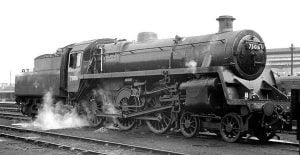
The basic dimensions and features of class include: 4-6-0 wheel arrangement (coupled wheels – 5 foot (ft) 8 inch (in), leading bogie – 3ft), BR4 boiler pressed at 225 lbf/in2, two outside cylinders (18in diameter and 28 in stroke) worked by Walschaerts valve gearing, total weight came in at 67.9 long tons (engine only) and a tractive effort of 25,515 lbf (BR 4MT).
Performance in Service
The class was allocated to three of the six BR Regions. The London Midland Region (mostly formed from Ex-London, Midland and Scottish Railway (LMS) routes) had the largest allocation, with 45 engines. Here, the class would work duties with similarly designed LMS engines, such as passenger and freight trains on branch lines and secondary routes.
20 engines stayed on the Western Region, where the 30 ‘Manor’ class engines were located. The class would handle mixed traffic trains along the steep gradients of South Wales Branch Lines and Secondary Routes.
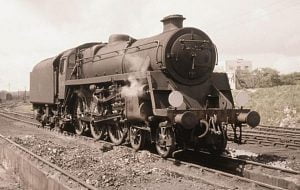
The last 20 engines moved onto the Southern Region, but engines received a couple of changes over the rest of the class. Firstly, the engines had bigger tenders fitted (BR1B (7 tons and 4725 gallons) over the usual BR2 and BR2A (6 tons and 3500 gallons). The bigger BR1B Tender reduces the class’s route availability.
The 2-6-0s
Doncaster Works’ drawing office had the task of designing the 2-6-0 Standard 4s, and also built 25 of the 115 total engines constructed. The designed followed closely to that of the LMS Ivatt Class 4s (More information on these can be found here) but sharing the same exterior appearance as and features of the other Standard Classes. Like the Ivatt Class 4s, the 2-6-0 Standard 4s would be allocated to Mixed Traffic duties, which they were suited to with their small coupled wheels.
Although sharing the same coupled wheel diameter as the Standard 3 Tanks under construction at Swindon Works (More information on this class can be found here), both classes used a different pattern for the wheels. This is unusual, especially as they both used the same design of cylinder casting.
The basic dimensions and features of class include: 4-6-0 wheel arrangement (coupled wheels – 5 foot (ft) 3 inch (in), leading bogie – 3ft), BR7 boiler pressed at 225 lbf/in2, two outside cylinders (17.5in diameter and 26 in stroke) worked by Walschaerts valve gearing, total weight came in at 59.75 long tons (engine only) and a tractive effort of 24,170 lbf (BR 4MT). The class received 3 different tender types, these are: BR1B (7 Tons & 4725 UK Gallons), BR2 (6 Tons & 3500 UK Gallons) and BR2A (6 Tons & 3500 UK Gallons).
Performance in Service
Only one of the six regions on BR didn’t receive the class when built, this being the Western Region.
- North Eastern Region – The 13 engines were spread across the whole of this region. Eventually, the class was based at either Kirkby Stephen or West Auckland, where the class operated on routes with strict loading gauges, such as the Stainmore route hauling both freight and passenger trains.
- London Midland Region – Engines here were based up North, in places such as Liverpool and Manchester. A few of the 15 locomotives were based in the Midlands at Leicester and Nottingham. Here the class mainly hauled perishable goods trains.
- Eastern Region – Two sheds took 15 engines, this being five at Stratford and ten at Neasden. These locomotives later left the Eastern Region in the 1960s and allocated to sheds on the Southern and Western Region.
- Scottish Region – Glasgow and the surrounding area was home to most of the 35 locomotives, but the class had been used on the Waverley Route, the Dumfries to Stranraer line and Aberdeen.
- Southern Region – This region had the biggest allocation, consisting of 37 engines. Based mainly between Southampton and Bournemouth, the class would venture as far as Cardiff and the Swanage Branchline. They could also be seen hauling the London Waterloo to Lymington boat trains, as they could fit on the turntables.
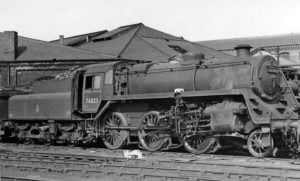
The 2-6-4s
Like both tender types, the Standard 4 Tanks were influenced by existing LMS designs, such as the Fairburn 2-6-4 Tanks. The design of both the LMS and BR Tanks was very similar, with only a couple of noteworthy changes. These were reshaped cab and general lowering height to meet loading gauge requirements across BR and smaller cylinder diameter & increased boiler pressure. Design work was conducted at Brighton Works, so was building 130 of the 155 total engines. Doncaster produced 10 and Derby built 15.
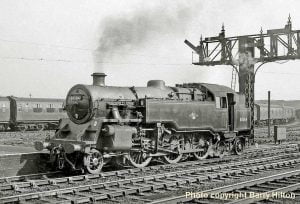
The basic dimensions and features of class include: 4-6-0 wheel arrangement (coupled wheels – 5 foot (ft) 8 inch (in), leading bogie – 3ft), ARB5 boiler pressed at 225 lbf/in2, two outside cylinders (18 in diameter and 28 in stroke) worked by Walschaerts valve gearing, total weight came in at 86.65 long tons and a tractive effort of 25,515 lbf (BR 4MT). The class held 7 Tons of Coal and 2000 UK Gallons).
Performance in Service
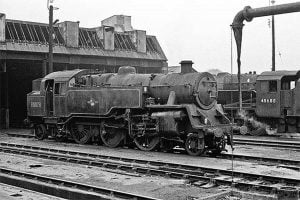
Due to a large amount of similar sized engines on the Western Region, none were initially allocated there. In the early 1960s, the Western Region received a small number of the class. The Southern Region retained many of the class is built and used them on Suburban Passenger trains around places such as London, Southampton, and Portsmouth. The Scottish Region used the class on similar duties around Glasgow, such as the commuter trains.
Decline and Withdrawal
The BR Standard 4s survived right up until the last years on BR steam. Each of the three types played a vital role in the areas they work. This lead to a late start in withdrawal compared to other classes, 1964 seeing the first groups of engines being scrapped. Some engines were transferred to another region due to electrification, particularly in the Southern Region were commuter trains were more suited to electric traction over steam.
Preservation
4-6-0s
Six engines of the class have survived preservation, with five of these being restored to running order.
- 75014 “Braveheart” – Restored to running order in 1994 a private group, 75014 has seen mainline action in the 90s and 00s, before being withdrawn for an extensive overhaul in 2004. Returning back to steam on the Dartmouth Steam Railway in late 2016 carrying BR Lined Black with Early Crest livery. Boiler ticket expires in 2026.
- 75027 – Purchased straight from BR, 75027 started hauling trains down the preserved Bluebell Railway as soon as the engine arrived in January 1969. It didn’t long for 75027 to show how useful it was on the line, being about to manage the steep gradients along the line but also be efficient on both water & coal and easy to maintain. Received multiple overhauls, the last one expiring in early 2007. The locomotive is currently stored awaiting overhaul in BR Lined Green with Late Crest.
- 75029 “The Green Knight” – Also purchased from BR, 75029 was originally owned by David Shephard who based the engine at the East Somerset Railway. The North Yorkshire Moors Railway acquired the engine for use on their line, where the locomotive retained its name. 75029 was passed to run to Battersby on the mainline. Currently withdrawn from traffic awaiting firebox repairs. Currently appears in BR Lined Green with Late Crest.
- 75069 – Restored at the Severn Valley Railway, returning in 1984, 75069 has seen both Heritage and Mainline running over the decades. Withdrawn and stored until it’s turn was up in the overhaul queue, an overhaul started in early 2013. Major work is needed to be carried out with no return date set.
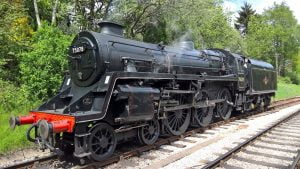 75078 – Operational on the Keighley and Worth Valley Railway, 75078 returned form overhaul in 2015. Restoration only took five years, with the engine arriving in Barry condition in 1972 and steaming in 1977. The engine has worked on the line since and currently wears BR Lined Black with Late Crest.
75078 – Operational on the Keighley and Worth Valley Railway, 75078 returned form overhaul in 2015. Restoration only took five years, with the engine arriving in Barry condition in 1972 and steaming in 1977. The engine has worked on the line since and currently wears BR Lined Black with Late Crest.- 75079 – The engine currently awaits restoration at the Mid Hants Railway, more information can be found here
2-6-0s
Only four of the 2-6-0s have survived into preservation, with three being restored so far.
- 76017 – Operational and based on the Mid Hants Railway, 76017 returned to traffic in 2016 following an overhaul. This was the first time the engine had run in two decades. BR Lined Black with Early Crest is the engine’s current livery.
- 76077 – Major components have moved this year to Loughborough based firm to under restoration. Was previously stored at the Gloucestershire and Warwickshire Steam Railway.
- 76079 – Operational and based on NYMR, passed to run to Battersby. Boiler ticket expires 2024 (Mainline 2021).
- 76084 – Operational and based on the North Norfolk Railway, Mainline certificated. Mainline works include both tours and dining train to Cromer. The locomotive returned to steam in Summer 2013 after 16 years of restoration.

Credit: Flickriver
2-6-4s
A large number of the Standard 4 Tanks have been preserved across the country. Of the 15 left, 12 have been restored.
- 80002 – Purchased straight from BR by the KWVR, the engine has been ideal for running trains along the line alongside 75078. Received a few overhauls over the years, with its last boiler ticket expiring in 2013. The engine currently is a static display.
- 80064 – Currently a static display while awaiting overhaul at the Bluebell Railway. Last boiler ticket expired in 1991. Carries BR Lined Black with Early Crest.
-
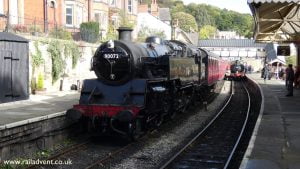
80072 at Llangollen 80072 – Operational and based on the Llangollen Railway. Restoration started in 1991, taking 19 years to compete, with 80072 returning to steam 2010. Last major work was in 2015 when boiler required attention. Wears BR Lined Black with Late Crest.
- 80078 – Operational at the Mangapps Railway Museum. The restoration was completed by Southern Locomotives Ltd in late 1999. The last overhaul was completed in May 2017.
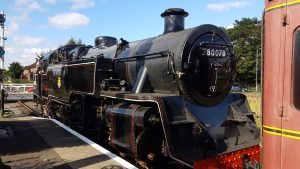
80078 at Dereham Station, Mid-Norfolk Railway // Credit Jamie Duggan, RailAdvent 80079 – Static display at The Engine House on the Severn Valley Railway. Received a few boiler tickets of it’s preserved life, last one ending in 2002.
- 80080 – Undergoing the final stages of an overhaul at the Midland Railway – Butterley. On completion and after running in trials, the engine will be based at the East Lancashire Railway. Restoration was completed in 1987 at the Midland Railway Butterley. 80080 has seen lots of work on the mainline, clocking up 37,000 miles.
- 80097 – Under restoration at East Lancashire Railway. Boiler back on Rolling Chassis, mainly refitting work need to complete the engine.
- 80098 – Undergoing overhaul at the Midland Railway Butterley. Last boiler ticket expired in 2009.
- 80100 – Awaiting restoration at the Bluebell Railway, in Ex-Barry condition
- 80104 – Operational and based on the Swanage Railway. Owned by Southern Locomotives Ltd who restored the engine to working order in Spring 1997. Current boiler ticket expires 2021 and carries BR Lined Black with Late Crest.
- 80105 – Undergoing overhaul at the Bo’ness and Kinneil Railway after boiler ticket ran out in 2010.
- 80135 – Undergoing overhaul at the NYMR. On completion mainline equipment will be fitted to allow the engine to run to Battersby. Only member of the class to carry BR Green in preservation.
- 80136 – Operational on the NYMR. Final stages of last overhaul were completed at the line. BR Lined Black with Early Crest livery applied.
- 80150 – Undergoing the early stages of restoration. (More information can be found here)
- 80151 – Undergoing overhaul at Bluebell Railway after last boiler ticket expired in 2012.
We hope enjoyed this week’s Class Information, even though we skipped a week due to the KWVR50 preparations. Stay tuned for the next week’s Sole Survivor.
- Visit the RailAdvent news homepage
For the latest railway news - Visit the RailAdvent Shop
For railway related goodies! - Visit LocoStop – Our New Social Network
Come and share your photo’s and video’s, join the discussion.
Find out what others are sharing






Responses
Check your descriptions of classes. The 2-6-0s and 2-6-4s are both stated as having 4-6-0 wheel arrangements. Missed typeO